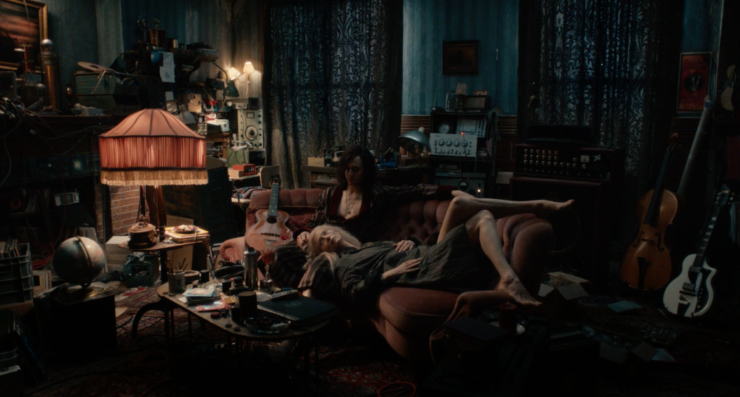A lonesome figure walks down a dark road, dwarfed by the tall buildings of a future metropolis, and around him advertisements play in bright pinks and blues, the light breaking through the dark smoggy night. A blood-covered woman runs through the snow in a billowing white dress, buttoned in lace from toe to chin, the clay turning over under her feet and leaving red footprints in her wake. A beautiful young woman peels away a section of her skin revealing mesh and mechanics underneath.
As humans, we are predisposed to crave beauty in our lives—you know, even in the most dire of circumstances, we seek out spring flowers, blue skies, a dazzling smile. When it comes to film, visual excellence can enhance the story in ways we, as an audience, might not even notice upon first watch. The lighting may shift towards a darker color palette as the plot thickens. The fabrics and dress style of our heroine may indicate something about her character. And then sometimes the camera is fully focused on Harley Quinn’s breakfast sandwich cooking on a bodega griddle and it’s just gorgeous. We can’t explain why, but it is. But all of these elements combine to takes us out of the real world. When it hits right, the movie screen is a portal.
Visuals have the capability to move us in undetectable ways, and sometimes we just want to escape into a beautiful, hyper-realistic world that’s a feast for our eyes. Here are a selection of visually immersive films you can stream now.
Crimson Peak (HBO, Hulu)
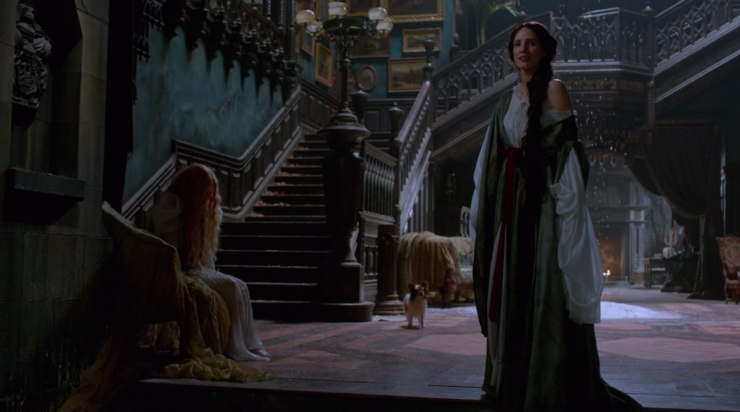
It’s no secret that Guillermo del Toro is a master of visual storytelling, and in this film particularly, the grotesque horror elements are matched equally with beauty, so much so that the sharp breath in your lungs is as much for the gorgeous, blood red, gothic apparitions as they are for the jump scares and body horror. When the daughter of a wealthy businessman (soon to be dead) is seduced by a suave Englishman Thomas Sharpe (it’s Hiddleston, who can blame her), she is whisked away to live in the old, aching family home with Sharpe and his sister Lucille; a home haunted by a host of dead wives. But—and here me out here—the real story is the clothes. Subverting the traditional gothic black, del Toro’s characters dance across the screen in muted marigold, deep turquoise, minty greens, and of course the titular crimson. Edith’s blush pink ballgown, with pearls at her shoulders and sweeping skirts paints her as demure, soft, virginal yet touchable—a stark contrast between the high-necked red worn by Lucille, with her blood colored rubies and countless buttons keeping her tightly in. But there is a switch later, and we find Edith looking ever the part of a Victorian Gothic Maiden in her white crinoline nightgown, with oversized puff sleeves and ruffles at her neck, like ghostly hands ready to choke. Across from her stands Lucille, her nightgown hanging tantalizingly off her shoulder, teal and crimson silks hanging loosely off her. She is coming undone, bearing her true self: unhinged and seductive, elegant and disheveled. I want every piece of clothing in this film on my body. I just maybe won’t ask who has worn them before.
Ex Machina (Netflix)
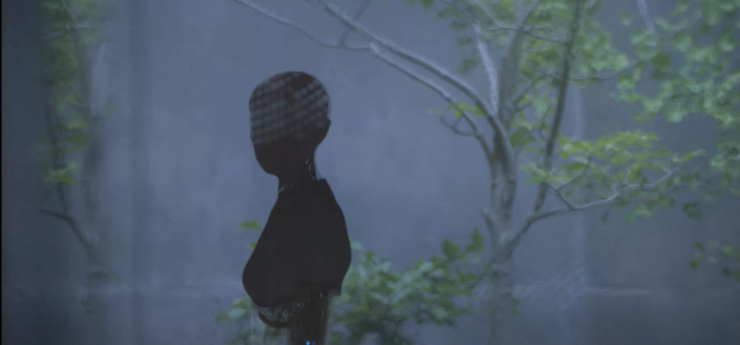
I’ll admit that Ex Machina’s inclusion on this list is due in no small part to Oscar Isaac’s face. But I’m fascinated by sleek, modern futures with ugliness at their centers; the juxtaposition of beauty and destruction. After winning a lottery, programmer Caleb ventures to the home of tech genius Nathan, a sort of hotshot Elon Musk type who runs a Google-esque company. Nathan invites Caleb to be the human element in a Turing test with his latest AI experiment, Ava. We watch Caleb enter into a room lined with glass, an observation room, wherein Ava exists on the other side. We see him gingerly touch a crack in the glass, and beyond, the dark silhouette of her amongst the trees. Ava, the AI in question, is only half covered (if you can call it that)—her face is a synthetic flesh that only extends to a non-existent hairline, her stomach and arms are transparent so we see the workings of the mechanics inside her. And she is beautiful, with her fluid movements and her careful speech patterns. Beyond, Nathan watches them in a workspace with triple monitors and a Beautiful Mind-level of post-it notes on the wall. What blossoms is a twisting of humanity, surveillance, and consent: it’s obvious to note that AI in fiction is a mirror for what it means to be human. What’s more interesting is looking into why humans want to create AI, why we want it to “pass”, and whether our creations want to exist in the first place. There is something much more to be said about the isolation, violation, and destruction of beautiful, robotic women here, but I’ll let Tochi go off on that.
Byzantium (Amazon Prime)
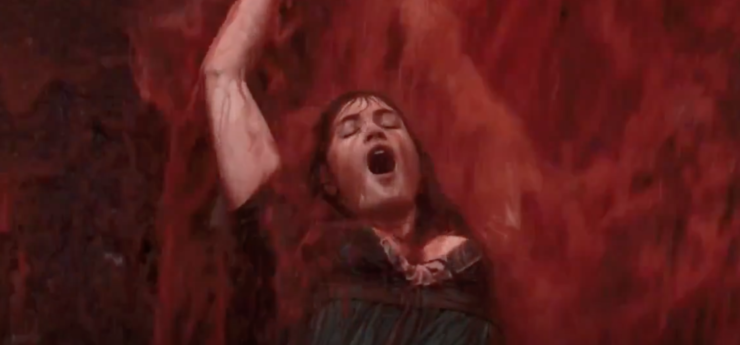
I could write a dissertation on blood in film, of blood in vampire films specifically, but Byzantium takes the cake. A 2013 indie film starring Gemma Arterton and Saoirse Ronan, Byzantium follows Eleanor and Clara, two vampires on the run. It’s a sort of gothic Chocolat—Eleanor and Clara are mother and daughter, moving town to town and leaving dead bodies in their wake. As with the best of vampire narratives, we’re presented with the problem of time, the way modernity clashes against the past. Clara is a sex worker: amid the flashing lights, fluffy prize toys, and carnival sounds of an amusement park, she brings a John behind one of the games for a dalliance. In the next moment, she’s walking the beach in an Edwardian dress, a woman ruined, a woman timeless. But where was I? Oh yes, the blood. At the hands of the Nameless Saint, eternal life is given. A waterfall of black stone that stretches into the sky, a small hut with an ancient being inside. We don’t see Clara go in, we don’t see her give herself to death. Instead we see her after her transformation: bathing in the gushing red waters that fall over her, a waterfall of blood. It is in her hair, her mouth, soaked through her dress. She is beautiful in ecstasy, reveling in her newfound power. And the blood continues to fall. In the way that vampire narratives are almost always a sexual metaphor, it is vampirism itself that is her lover here, vampirism that makes her feel whole. When asked how she will use this power, she answers: “To punish those who prey on the weak. To curb the powers of men.”
Plus there’s a shot of Trinity Library and that’s always a visual thrill.
Only Lovers Left Alive (Hulu)
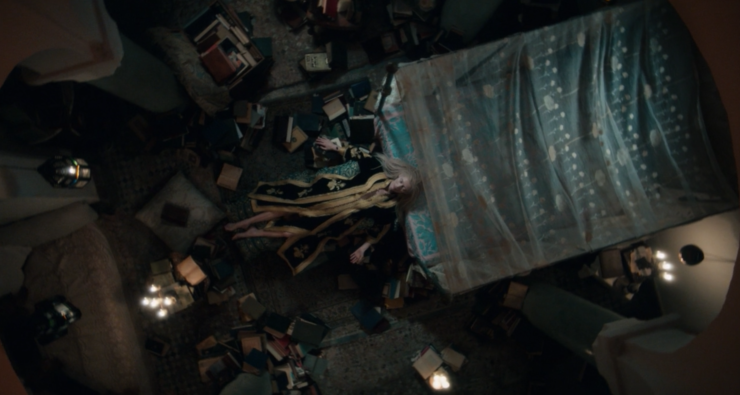
Part of my adoration of this film is the perfect bohemian set design. Both Adam and Eve live in this gorgeous artistic squalor, Adam in an old house in Detroit filled with wires and vinyl records, rare vintage guitars that only an intensely passionate creator would seek out; Eve in Tangier is surrounded by a towering, overflowing book collection that makes me salivate with want. Both of them are surrounded by many lifetime’s worth of stuff, each room so lived in, each space indicative of their personality. We watch Eve lay on a bed with silk and velvet pillows as she Facetimes Adam from her iPhone—on the other side of the world, Adam has hooked up a 1960s television screen and a broken old laptop to answer her call from a couch that looks like it was taken from someone’s grandmother. And it is the twinning of these two characters that makes this film move the way it does—their matching jewelry, the elegant way they take their blood in hock glasses, the balance of darkness and light, joy and angst. The decaying city of Detroit (not Detroit’s fault, mind you, it is a city systemically ignored) is still alive and wonderful in Adam’s eyes. The streets of Tangier are ancient and forever as we walk through the night with Eve. Modernity and antiquity exist in harmony. All of these things orbit around each other, Adam and Eve acting as two poles in perfect balance. And vampire narratives are always about dichotomies, to an extent—life and death existing at the same time, humanity and monstrosity. But director Jim Jarmusch has a unique way of balancing these things so that they aren’t at odds. Just as Adam and Eve exist both separately and together, beauty and decay are given equal weight. And we, as viewers, are held delicately and safely between them.
Annihilation (Hulu)
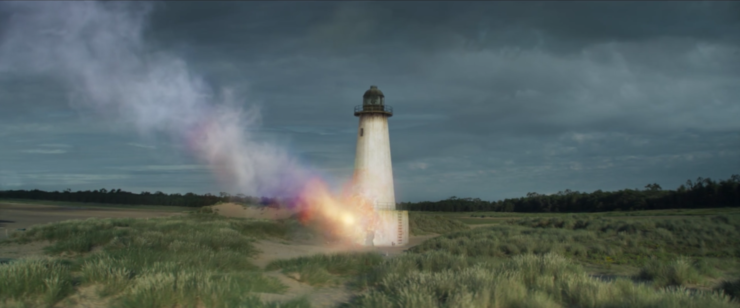
It matters that they’re women, the group that enters the Shimmer. I know people will disagree with me here, but it does. It matters that they’re intelligent, brave, damaged women. It matters that they come to this thing as something to be understood and explored rather than something to be conquered or subdued. The Shimmer is beautiful. Area X is beautiful. It’s the iridescence of a soap bubble catching summer sunlight, colors warped and swirling on the surface. Inside, the land is covered with lush green, the trees are draped in Spanish moss, the flowers bloom bright and crawl over structures in their path. It is a wetland, a swamp unlike any other, filled with abundance. As the group of women scientists paddle through the clear waters, there are fish and blossoms and green underneath. The moss curled against the trees is bright orange, turquoise, pink, glistening like crystal. Area X is, for lack of a better phrase, over the rainbow. Of course, it’s horrific too. After the group realizes that The Shimmer is refracting DNA, scrambling the codes that define human, plant, and animal, it’s clear that Area X is only just getting started. The Shimmer is changing them. There is a moment, after the death of their compatriot, where Josie is waiting outside for Lena. We see that tiny green sprouts and vines have started to grow along her arms, her DNA changing. Rather than die in fear, she accepts her fate. She lets The Shimmer take her. She gives herself over to the earth. Lena is left to go alone, forward into an uprising of crystal trees.
And okay yeah okay fine, this one’s about Oscar Isaac’s face too.
Blade Runner 2049 (Amazon Prime)
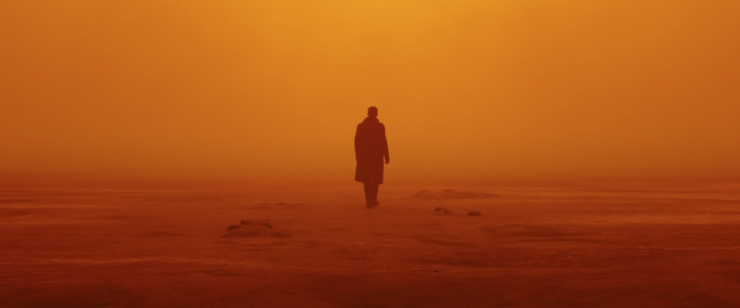
There are a lot of mixed feelings about the newest Blade Runner—fans of the original film feel protective, as we who love things so often do, of the narrative and its characters. But no matter how you feel about the story, it is beautiful to watch: cinematographer Roger Deakins and the production designer Dennis Gassner build upon the gritty, dystopian Los Angeles depicted in the first film to bring us neon futurism, just as informed by our current minimalist style trends as the original was by the ’80s. The urban grime and darkness is cut by bold color—a towering Ana de Armas in neon pink and blue—so much so that it becomes integral to the storytelling. The plot isn’t terribly fast paced, so the audience is treated to visual decadence. Cameras linger so we watch drops of rain on the windows, two characters breathing and watching each other inside a room. Moments hang. We watch Luv, in a white dress, walk up a set of stairs, a pattern of marigold-colored waves reflected on the walls around her. In the next moment we see her approach Niander Wallace on a platform surrounded by water—he is a lone man on an island, cloaked in darkness, difficult to reach. We hear him before we see him, and slowly that marigold light reveals his silhouette; he becomes a figure bathed in gold. His reality is so far removed from that of Kay, our Blade Runner, who operates on a street level, constantly barraged with people and noise and movement. But then we watch Kay travel across the desolate earth in search of Deckard, bathed in that same sunset-colored light, the same glow that travels through the large windows of Deckard’s home as they meet for the first time. It is a color we associate with warmth, life, summer, yet here it becomes sinister and rusted. But still an equalizer—all these men are part of the same world, all orbiting around each other. We watch the shades of it shift over their faces. We watch the light fade to a blissful, restful white. And everything becomes still.
Pan’s Labyrinth (Netflix)
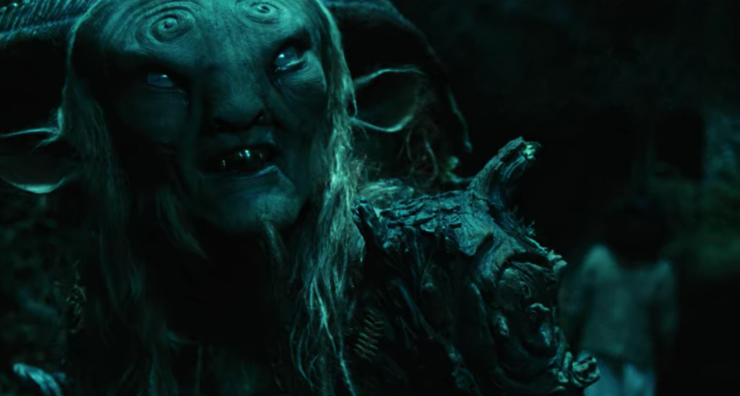
Any of us who have craved other worlds, who have dreamed of finding a portal or being whisked away to a place far away from here can see ourselves in Ofelia. It’s a film for all of us who were told we’re too fanciful, told to put away fairy tales and childish stories and focus on reality. Ofelia’s reality is, understandably, unsatisfactory: when her mother marries a Spanish captain, she is moved from her home to a fort in the country where the military is hunting Spanish Maquis that hide in the hills. It is a world of violence under an iron-fisted regime, and Ofelia’s new step-father is at the center of it. It’s no wonder, then, that she follows a fairy and descends the ancient moss-covered stone steps into the Labyrinth. Wouldn’t we all? And El Fauno is there to greet her: with his ram-like horns, his body that seems to be made out of stone and tree bark all covered in patterns and runes. “I’ve had so many names,” he says, like ancient beings always do, “old names that only the wind and the trees can pronounce. I am the mountain, the forest, and the earth.” Yes, this is the second del Toro world on this list, because he’s a goddamn genius. Ofelia’s first task finds her crawling under a tree and ruining her new shoes in service of getting a key from the stomach of a frog; the princess emerges covered in mud. In the film’s most iconic scene, Ofelia walks down a bright red hallway that looks like the inside of an intestine to face the Pale Man, del Toro’s monster of privilege and greed (don’t we all know a white man with food he won’t share?). His table is filled with berries, persimmons, mangoes, and wine—all just slightly too ripe, slightly too juicy, as if blood would erupt from them at first bite. It is the destruction of beauty that causes distrust—aren’t princesses supposed to be taken away from monsters? Isn’t there supposed to be a happy ending? But Ofelia’s journey isn’t so easy. The fairy tale jostles against the real world: both awe-some and ugly, brilliant and terrifying. Through this lens, through Ofelia’s eyes, we are reminded that everything has a price. We only need decide what we are willing to pay.
Birds of Prey: And the Fantabulous Emancipation of One Harley Quinn (Amazon Prime)
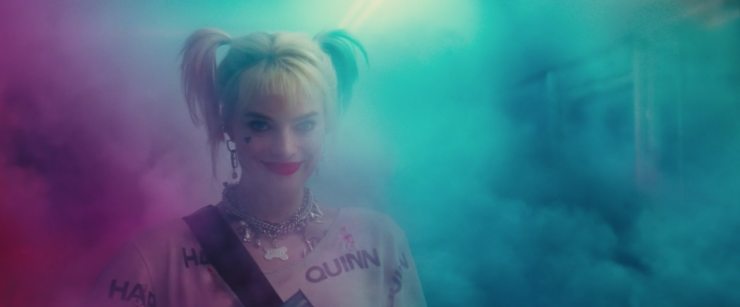
It’s probably become really obvious that we’re all Birds of Prey stans over here at Tor.com, and for one very obvious reason: it’s the best movie of all time. Fight me. Not only is it entirely devoid of the male gaze (thank goodness), every shot is well-made and meaningful. It’s incredibly difficult to make a comic book movie that doesn’t look cartoony. We’ve seen a definite turn against that look with male-led superhero films; in an effort to be taken seriously, directors moved towards gritty reality and away from, well, color. So it would be understandable if Birds of Prey had followed in those footsteps, wanting to keep in step with the boys, as it were. But director Cathy Yan did the exact opposite, and it’s fucking beautiful. Birds of Prey is a confectionery of color that brings the audience into a hyper-reality that still manages to stay away from cartoony-cheesy territory. We watch Harley walk away, limping in one shoe and one sequined sock, from a chemical plant that is exploding in bright pink and blue fireworks. In the next scene, we’re treated to the most delectable visuals of a bodega breakfast sandwich, and the Chef’s Table-level cinematography creates a 3-minute love story between Harley and her egg, bacon, and cheese. Then we’re balls-deep in an epic fight scene in a police station: be-heeled Harley wields a gun that shoots bean bags, red and blue paintballs, and blasts of glitter, creating clouds of joy behind her to the point that it looks like she’s fighting through Coachella. Coupled with Margot Robbie’s facial gymnastics leaping from broken-hearted ingenue to wise psychologist to give-no-fucks party girl with Simone Biles level efficiency, Birds of Prey is a visual feast that lays the smack down on its testosterone-fueled predecessors. And it does that in sequins.
Christina Orlando is the Books Editor & Publicity Coordinator for Tor.com, where they get to be a book nerd all day. As a freelance writer covering poetry, gender, and sexuality, their work has appeared Electric Literature, gal-dem, THEM, Adroit Journal, and Book Riot. They are the winner of Spotify’s Sound Up grant for people of color in podcasting, and their first audiodrama will debut later this year.










